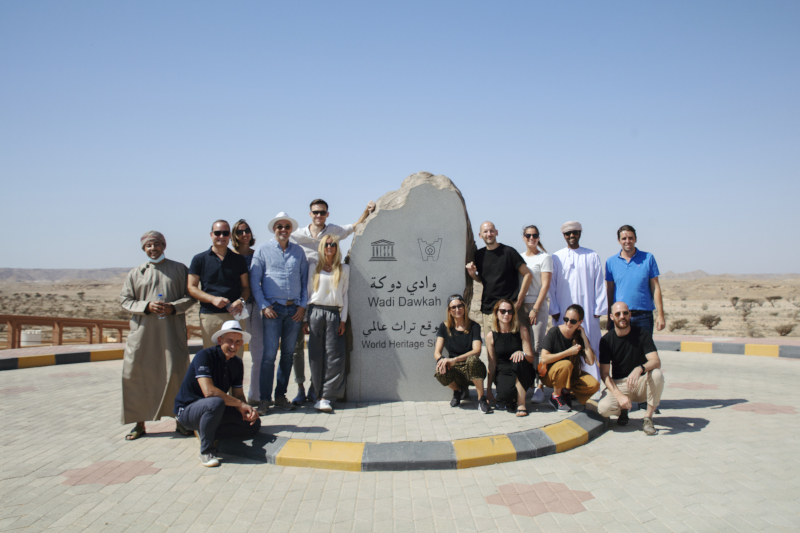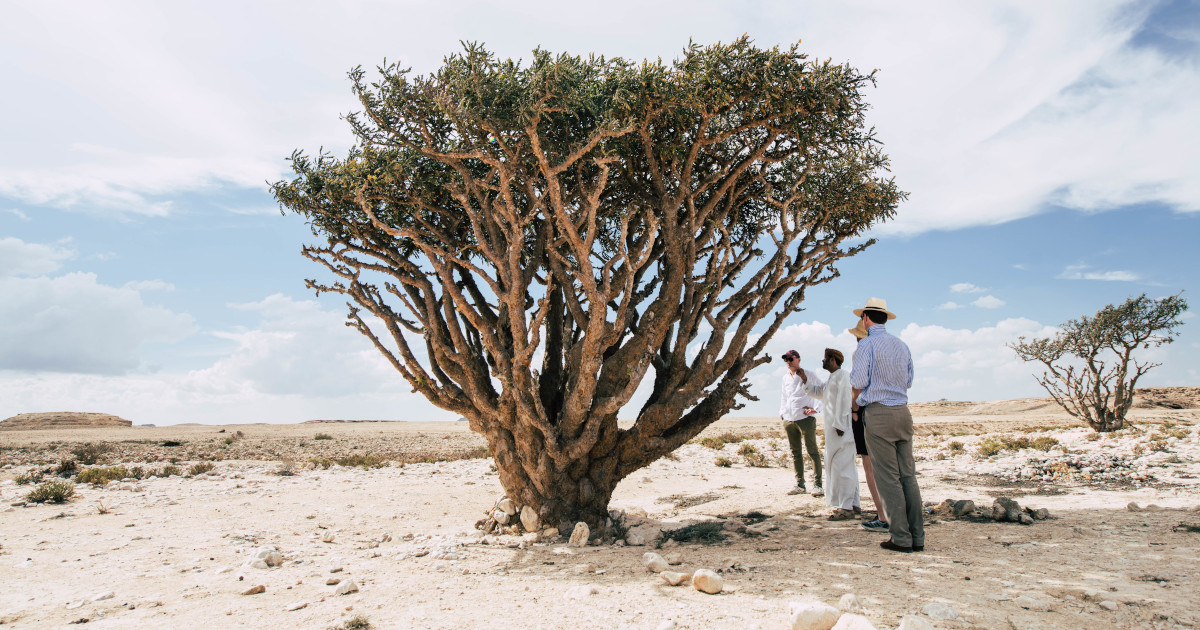Cette publication est également disponible en :
Français
In Oman, the creative director of Amouage, a company founded in the sultanate in 1983, is overseeing a vast project that will combine responsible production of the precious resin with tourism and cultural activities.
Amouage signed a partnership with Oman’s Ministry of Heritage and Tourism in 2022 to run a historic frankincense production site. What does this agreement involve?
In Oman, four UNESCO World Heritage sites make up what is known as The Land of Frankincense: the ports of Khor Rori and Al-Baleed, the archaeological site of Shisr (also known as Ubar) and Wadi Dawkah – a wadi is generally a canyon carved out by a former riverbed. The partnership concerns the management of the wadi site. It covers a large area (five square kilometres) and is dedicated to the cultivation of Boswellia sacra, a variety of frankincense tree. Amouage has been given a two-pronged mission for the coming decades: to produce the raw material and develop tourism at the site. The creation of a nursery where 5,000 to 6,000 trees are currently growing will make denser cultivation possible. For the moment, there is only a road, a car park and some buildings to provide shade for visitors. The specifications require us to protect the biotope as well as the site’s historical heritage.
Who is your target audience?
The site will be open to everyone. The aim is not to make it a destination with an entry fee. Initially we’ll be targeting perfume lovers. The idea is that they can say to themselves, “well, one day I’ll go there”, in the same way as people plan to go to Grasse. In terms of perfume tourism, Oman already has the city of Muscat, where the Amouage factory is open to visits. There is also Jebel Akhdar, known as the Green Mountain, renowned for rose growing. We’re planning to make improvements there to further optimise visitor facilities. We want to make Wadi Dawkah the country’s third perfume destination. To start with people will go there to discover the birthplace of frankincense, with the cultivation of trees. Then, in a few years’ time, the public will be able to observe resin being harvested, extracted and packaged before being exported to Muscat and throughout the world. The first target audience will therefore be connoisseurs.
And other than perfume lovers?
We won’t forget visitors who have less of a connection to this industry. People looking for an additional tourist activity will be able to enjoy an educational approach and the sale of local frankincense products on site – and not only Amouage products, I should add. Then, more broadly, we will target the inhabitants of Oman and the Middle East. The wadi is close to Salalah Airport and is a popular tourist destination in July and August, when the climate is more temperate. Local visitors will get the chance to rediscover an ingredient they use at home as a perfume as well as part of their daily rituals.
What activities will you organise at the site?
The site is criss-crossed by a ten-kilometre trail that can be used by local guides we will involve in the project and train. The route will have about ten stops. I’m working on installing works of art centring on the theme of frankincense. I’m currently in discussions with local and international artists. The different spots are very photogenic and lend themselves well to the organisation of concerts and shows: I’ve even found a space that has a naturally arch shape, like an amphitheatre. I’d like to add an olfactory dimension that fits with the site.
How do you intend to find a balance between tourism and sustainable development, a theme that is unavoidable nowadays when it comes to raw materials?
It’s up to us to find the right balance. There’ll be the nursery at the entrance to the wadi, but 98% of the site will remain wild. We’re still wondering, for example, about the water supply for the shrubs that are going to be replanted. Are they overprotected? Could they regulate themselves? As for the incisions made in the bark – tapping – how can we ensure that they are carried out without weakening the trees? We are defining these practices with local people, who are very knowledgeable on the subject. And we’re comparing them with the practices in other producer regions: Somaliland, Puntland (an autonomous region in north-western Somalia) and even Yemen. I think that by developing this high-end frankincense we will be able to meet the demand for an outstanding product, and do it at an affordable price. We have the support of experts in raw materials and fragrance. Some of them have already paid us a visit.
Who, for example?
The raw material sourcers Dominique Roques, Stéphane Picard and Guillaume Delaunay, as well as experts from LMR (IFF subsidiary) and Maison Lautier (recently relaunched by Symrise). A dozen perfumers went to Oman to evaluate the frankincense with us, including Alexandra Carlin, Cécile Zarokian, Karine Vinchon-Spehner, Domitille Michalon-Bertier, Bruno Jovanovic, Quentin Bisch, Julien Rasquinet, Rasquinet, Alexis Grugeon, Pierre Négrin and Dominique Ropion. A consensus emerged. It’s an incomparable product with incredible facets. Its high alpha pinene content (between 55% and 75%) gives it a particularly powerful terpenic aspect, but that can easily be fractioned. This is a signature product, a really striking ingredient. It’s almost a perfume in itself. It has an aroma of citrus, grapefruit and pepper with a persistent and very colourful mineral freshness. All the perfumers and ingredient experts are blown away by it.

Will it be used exclusively for Amouage, or will you share this treasure?
The aim is not for Amouage to have sole use of the wadi’s production: we want to export the frankincense under the name of “Oman Frankincense”. We have a three-year development plan. During the first year, which has already begun and will end in October 2023, we will carry out an initial trial harvest on trees already present on the vast site, to characterise the frankincense and its olfactory profile and try to determine whether there are different qualities. The next two years will be devoted to developing the tourist infrastructure as well as to setting up the extraction plant – we’re currently considering the best solutions for this project.
What role do you intend to play in this frankincense trade in the future?
Frankincense is a key ingredient in perfumery. It fosters a lot of creativity without being too expensive: its essence costs between 100 and 300 euros per litre. So it’s not just for an elite. But frankincense represents one of the opaque and controversial sectors. The houses deal with traders and there are many intermediaries. When you buy frankincense today, you are probably the tenth person to touch the resin. This is also linked to its history, its use as a currency: people pay with it, the product passes from hand to hand and the added value is often created to the detriment of the grower. Today, brands are communicating more and more about natural products. They would like to be associated with a more transparent supply chain. This is what we can provide. We also want to put the focus on the growers. The wadi is their work tool. So they will be in charge of the visits.
There really is plenty that can be done to move in the right direction, in the sense of a virtuous circle, by raising the profile of an ingredient inextricably linked to the history of perfumery, but also to mythology and religion.
Pictures : © Amouage








Really this a fabulous and Great project, which I was dreaming of such activities since the early nineties while I was working in the D.G of Agriculture in Salalah. Although I performed some limited work in this context (e.g frank. seedlings production, transplanted frank. seedlings in some sites (around 20 thousands), encouraging farmers and others to plant these trees and to protect the wide frank. from grazing and some other activities,,I Instructed by my Director to join the UNISCO. Team and to survey Wadi Dokah in addition to supply frank. seedlings (3000 seedlings) to be transplanted in the selected Site in addition to these activities I performed a proposal of a National Strategy For Frankincense Rehabilitation 2008 revised 2011,, and submitted to the M. of Agric. ),, anyhow I tackled in that Strategy some Opinions that related to your Comprehensive Project,,, thank you so much for your project,, because I am seeing my dreams is going to be a realistic and shall be applied while I am still in Salalah
Ny Best Wishes,
(Expatriate Forest Engineer (Sudanese))
Tel. 0096892399306)